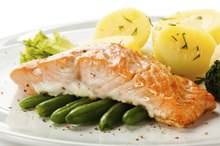What does fact checked mean?
At Healthfully, we strive to deliver objective content that is accurate and up-to-date. Our team periodically reviews articles in order to ensure content quality. The sources cited below consist of evidence from peer-reviewed journals, prominent medical organizations, academic associations, and government data.
- Journal of Pediatrics; The Influence of Sardine Consumption on the Omega-3 Fatty Acid Content of Mature Human Milk; Rose Patin, et al.; January-February 2006
- Journal of Pediatrics; The Influence of Sardine Consumption on the Omega-3 Fatty Acid Content of Mature Human Milk; Rose Patin, et al.; January-February 2006
The information contained on this site is for informational purposes only, and should not be used as a substitute for the advice of a professional health care provider. Please check with the appropriate physician regarding health questions and concerns. Although we strive to deliver accurate and up-to-date information, no guarantee to that effect is made.
What Is the Fish Oil Content in Anchovies & Sardines?
Anchovies and sardines are little fish with nutritional strength to improve your health. These fish contain oil that is highly concentrated with healthy fats, primarily polyunsaturated fatty acids called omega-3 fatty acids. Increasing your dietary intake of omega-3 fatty acids from fish improves your cardiovascular health and reduces inflammation associated with rheumatoid arthritis and colitis. Omega-3 fatty acids are also important to growth and development and brain function.
Anchovies
Anchovies are the richest fish when it comes to the concentration of omega-3 fatty acids. Anchovies contain 3.4 grams of omega-3 fatty acids in a 6-ounce serving. Omega-3 fatty acids in anchovies include eicosapentaenoic acid and docosahexaenoic acid. Anchovies also contain monounsaturated fatty acids and another type of polyunsaturated fat called omega-6 fatty acids. Nonetheless, it is the omega-3 fatty acids that make anchovies a healthy treat. Many other foods, such as vegetable oils, contain omega-6 fatty acids, but fewer foods contain omega-3 fatty acids.
- Anchovies are the richest fish when it comes to the concentration of omega-3 fatty acids.
- Anchovies also contain monounsaturated fatty acids and another type of polyunsaturated fat called omega-6 fatty acids.
Health Benefits of Anchovies
Is There Limit to How Much Tuna Fish and Sardines You Can Eat?
Learn More
Eating anchovies helps you increase the amount of omega-3 fatty acids in your diet. People who eat a higher ratio of omega-3 fatty acids to omega-6 fatty acids are less likely to develop heart disease. Unlike albacore tuna, a fish that contains high amounts of omega-3 fatty acids and mercury, anchovies are among the few fish with high levels of omega-3 fatty acids that are also low in mercury and other toxins. Mercury is a heavy metal that can cause nerve damage and birth defects. Anchovies are also a good source of protein.
- Eating anchovies helps you increase the amount of omega-3 fatty acids in your diet.
- Unlike albacore tuna, a fish that contains high amounts of omega-3 fatty acids and mercury, anchovies are among the few fish with high levels of omega-3 fatty acids that are also low in mercury and other toxins.
Sardines
Sardines contain high amounts of omega-3 fatty acids and low amounts of mercury. Pacific sardines contain 2.8 grams of omega-3 fatty acids per 6-ounce serving. Sardines also contain omega-6 fatty acids and monounsaturated fatty acids. Plus, sardines are a good source of protein, vitamin B-12, vitamin D and calcium.
- Sardines contain high amounts of omega-3 fatty acids and low amounts of mercury.
Sardines and Breast Milk
Protein Content of Canned Salmon
Learn More
The nutritional composition of breast milk impacts the health of the infant. Nursing mothers who eat sardines are able increase the content of omega-3 fatty acids in breast milk. Scientists at the Federal University of Sao Paulo in Brazil found that nursing mothers who eat 100 grams of sardines two or three times per week are able to increase concentrations of omega-3 fatty acids in breast milk, according to research published in the January-February issue of the "Journal of Pediatrics" in 2006 124. The results demonstrate that regular consumption of sardines and shorter intervals between eating sardines and lactation result in higher concentrations of omega-3 fatty acids in breast milk.
- The nutritional composition of breast milk impacts the health of the infant.
- Nursing mothers who eat sardines are able increase the content of omega-3 fatty acids in breast milk.
Related Articles
References
- University of Maryland Medical Center; Omega-3 Fatty Acids; June 2009
- University of Maryland Medical Center; Omega-6 Fatty Acids; 2010
- United States Environmental Protection Agency; Consumption Advice: Joint Federal Advisory for Mercury in Fish; 2004
- Journal of Pediatrics; The Influence of Sardine Consumption on the Omega-3 Fatty Acid Content of Mature Human Milk; Rose Patin, et al.; January-February 2006
- None
- None
- None
- None
- None
- None
- None
- None
- None
- None
- None
- None
- None
- None
- None
- None
- None
- None
- None
- None
- None
- None
- None
- None
- None
- None
- None
- None
- None
- None
- None
- None
- None
- None
- None
- None
- None
- None
Writer Bio
Jeffrey Traister is a writer and filmmaker. For more than 25 years, he has covered nutrition and medicine for health-care companies and publishers, also producing digital video for websites, DVDs and commercials. Trained in digital filmmaking at The New School, Traister also holds a Master of Science in human nutrition and medicine from the Columbia University College of Physicians and Surgeons.









